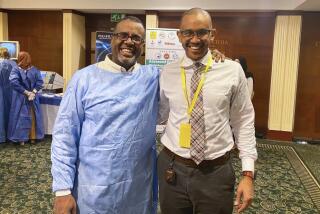U.S. Evacuates Ethiopian Jews : Last Group of Falashas Secretly Airlifted From Sudan to Israel
- Share via
GEDAREF, Sudan — The last group of Ethiopian Jews in Sudan was airlifted Friday by U.S. military transport planes to Israel from a refugee camp on the plains of eastern Sudan in an operation planned by the U.S. Central Intelligence Agency, The Times has learned.
The Ethiopian Jews, known as Falashas, were moved in a top-secret and closely timed operation that began at dawn, when the first of about 10 turboprop C-130 transport aircraft landed at a gravel airstrip about eight miles north of Gedaref.
The Falashas, who had been moved during the night from the Tawawa refugee camp, about six miles away, were loaded swiftly, probably in groups of 80 to 90, with each plane staying on the ground only as long as necessary. The planes landed and took off one at a time and, once airborne, were believed to have followed a course over the Red Sea to the Mediterranean and then to Israel, where the Falashas will be resettled.
Meeting With Bush
It was learned from reliable sources here that the approval for the operation came directly from the White House. The groundwork for the dramatic conclusion to the Falashas’ story in Sudan was laid in a meeting between Vice President George Bush and Sudanese President Jaafar Numeiri on March 6.
Over tea in the president’s Khartoum offices, Numeiri reportedly told Bush that he had no objection to the removal of the Falashas from Sudan, provided it was done quickly and quietly.
About 7,800 Falashas were taken from Sudan to Israel from Nov. 21 to Jan. 6 in a secret airlift called Operation Moses, which ended two days after news of the airlift was leaked in Israel.
The Falashas issue is a delicate matter for the Sudanese. While Numeiri’s government is a close ally of the United States, Sudan is a member of the Arab League and has no relations with Israel. When the story of Operation Moses broke, the airlift was denounced by several Arab states, among them Kuwait, Egypt and Jordan. Most of the criticism, however, was directed at the Israelis and scarcely mentioned the Sudanese.
‘I Won’t Help Israel’
In an interview after the first airlift, Numeiri said: “I won’t help Israel by sending them more people. But if they want to go away from here--to Europe, to the United States, to anyplace else--I don’t care.”
That comment apparently was the basis of Bush’s quickly concluded negotiations with Numeiri.
Planning for the operation began March 7, the day Bush left Khartoum on the next leg of his trip through drought-stricken Africa. Informed sources said the prime mover in the plan was the CIA.
Plans for the operation called for the planes, furnished by the U.S. Air Force, to fly in from Europe and perhaps refuel in Kenya before coming to Sudan.
It could not be determined immediately how many Falashas were airlifted Friday, but about 900 of the Ethiopian Jews--who have lived as refugees in Sudan for about a year--were believed to have been in the Gedaref area, about 200 miles southeast of Khartoum. Nearly all were housed in straw huts at the southwest corner of the Tawawa refugee settlement.
That area of the camp was deserted early Friday morning after the airlift.
“Not a soul was stirring there,” said Jim Taylor, a British volunteer working in the camp. “It was completely empty.”
On Thursday, the same area had been well-populated by thin and ragged children and worried-looking adults, most of whom insisted that they were not Falashas.
This reporter was in Gedaref at the time of the airlift but was detained by the Gedaref branch of the Sudanese State Security Office after he was seen approaching the airstrip late Thursday afternoon. The reporter was held in the state security compound for 16 hours and released when the operation was apparently completed.
Completed in 4 Hours
From the state security compound, the drone of airplane engines could be heard clearly, beginning at 6 a.m. Friday. Sudanese security officers began returning to their headquarters, covered with red dust and carrying flashlights and assault rifles, by 10:30 a.m., presumably an hour after the airlift was finished. That would indicate that the operation, apparently run with precision and efficiency, was completed in less than four hours.
For the poor, back-country Falashas, whose saga throughout the last year has been one of fear, forced marches and starvation, the airplanes that came to bear them away to a new life must have been an awesome and even terrifying sight.
The Falashas, who believe themselves to be the descendants of the Queen of Sheba and are often described as a “lost tribe of Israel,” long have been a persecuted minority in Marxist Ethiopia. They were forbidden to own land, and their children were kept out of schools. Their plight in recent years has attracted the attention of human rights organizations and Jewish groups in Israel, Europe, Canada and the United States.
About a year ago, thousands of Falashas, fleeing drought and famine, began to leave their homeland in Ethiopia’s Gonder province to make their way to refugee camps in Sudan.
Guided by Bandits
It is believed that many of them hired Ethiopian bandit gangs (known as shifta) to guide them out of Ethiopia, and many reported being robbed by their guides on their long, arduous journey out of the Ethiopian highlands.
Once in Sudan, about 1,200 are believed to have died in refugee camps such as Um Rakoba, which suffered severe food shortages last May, June and July. Their problems were compounded by their secrecy; they often refuse to seek medical treatment out of fear that they will be identified and perhaps persecuted.
Operation Moses took most of the surviving Falashas out of the country. They left on a chartered European airline, Brussels-based Trans-European Airline, and, after a brief stop on European soil, went on to Israel. When Operation Moses ended, about 900 Falashas were still left in Sudan.
Low-Profile Operation
It was learned that top U.S. officials wanted to mount the operation to remove these last Falashas within days after Bush’s departure from Khartoum. But unknown logistical problems delayed the airlift for two weeks.
It was a low-profile operation. At the airstrip, 24 hours before departure time, there was no sign of activity.
In the early morning, residents of the village only a quarter of a mile away were going about their morning chores. Shepherd boys led their flocks of sheep and goats from the village compounds, crossing the red, 2,700-foot-long airstrip on their way into the surrounding countryside, a landscape that has not seen rain since last July. A decomposing camel lay at the junction of the road and the airstrip.
Around 5 p.m. Thursday, through the heat waves that rose over the land, this reporter approached the area and saw two large radio antennae erected on a small hill above the runway, which was surrounded by several vehicles.
Turning back toward Gedaref, this reporter was stopped by a pursuing car and identified. Two hours later, an official of Sudan’s State Security Office came to the Gedaref house where the reporter was staying and asked that he come for an interview with the area’s security chief. After brief questioning, the reporter was kept inside the compound and was provided a bed for the night.
Plane Engines Heard
At 5:55 a.m. Friday, as the thin morning clouds were reddened by the rising sun, the first airplane engines could be heard clearly. They droned steadily for an hour and a half, and then the generator in the security compound was started and drowned out all distant noises.
It was learned, however, that the evacuation plan called for the Falashas to be moved out of Tawawa at night by truck.
The Falashas’ location in the camp provided easy access for the trucks, which could then skirt the edge of the settlement by a trail that joins the rough dirt road to the airstrip. The movements would have attracted little attention in the camp, which has a total population of about 16,000 Ethiopian refugees, many of whom would have given all their meager possessions to join the Falashas in their exodus.
Sources here say that President Numeiri is expected to easily ride out any criticism for his tacit support for the airlift. To the Arab world, Numeiri may say that he was “double-crossed” and that the Americans had promised him that the Falashas would be taken to the United States, not Israel.
Sudanese May Criticize
Inside Sudan, some criticism may come from more radical Muslim figures, but Numeiri recently has moved against many of them, jailing about 200 and firing others from their government jobs. Some Sudanese, even Muslims, applauded these moves when they were taken about two weeks ago.
For most Sudanese, Israel’s problems with the Arab world seem far removed from their daily concerns. Whatever Numeiri’s alliances with the Arab world, Sudan remains more African than Arab.
It is unlikely that Friday’s airlift managed to get all the Falashas out of Sudan, experts say, for there may be a small number who were not in Tawawa, or who just crossed the border from Ethiopia, where it is believed that as many as 10,000 remain. Those who are still in Sudan are likely to be resettled through normal, official channels, which have been operating in Sudan for some years.
More to Read
Sign up for Essential California
The most important California stories and recommendations in your inbox every morning.
You may occasionally receive promotional content from the Los Angeles Times.













